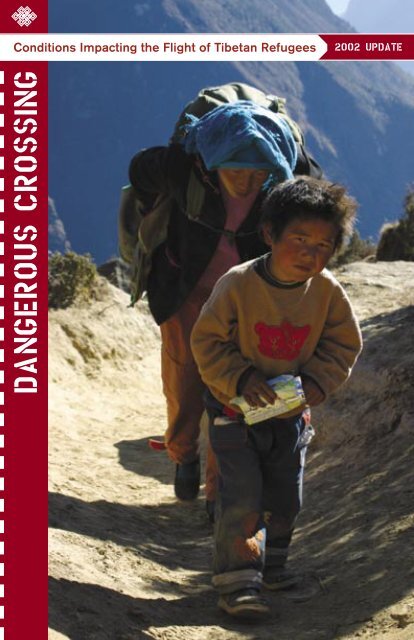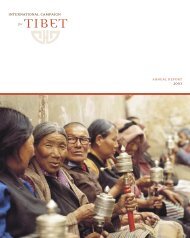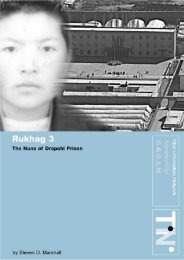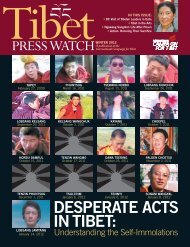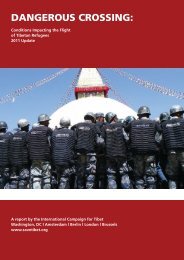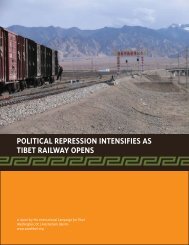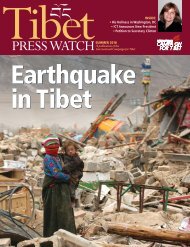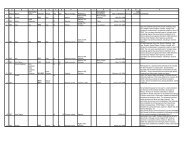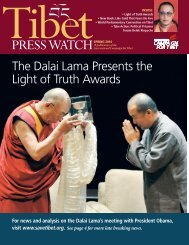download the report - International Campaign for Tibet
download the report - International Campaign for Tibet
download the report - International Campaign for Tibet
- No tags were found...
Create successful ePaper yourself
Turn your PDF publications into a flip-book with our unique Google optimized e-Paper software.
dangerous crossingConditions Impacting <strong>the</strong> Flight of <strong>Tibet</strong>an Refugees2002 Update
Dear Reader:May 31, 2003As <strong>the</strong> 2002 update of Dangerous Crossings goes to print, news fromNepal is deeply troubling. In stark contravention of <strong>the</strong> agreementbetween <strong>the</strong> UNHCR and <strong>the</strong> Nepalese government that provides <strong>for</strong><strong>the</strong> safe transit of <strong>Tibet</strong>ans through Nepal,” 18 <strong>Tibet</strong>an refugees were<strong>for</strong>cibly repatriated today. Nepalese and Chinese authorities workingtoge<strong>the</strong>r removed <strong>the</strong> <strong>Tibet</strong>ans from a Kathmandu jail early this morning.The <strong>Tibet</strong>ans were loaded onto a bus with a covered license plate anddriven to <strong>the</strong> border where <strong>the</strong>y were handed over to Chinese borderguards at <strong>the</strong> Friendship Bridge.Non-refoulement (<strong>for</strong>cible repatriation) is a fundamental principle ofinternational refugee law, and today’s action took place despite stronginternational protests on behalf of <strong>the</strong> <strong>Tibet</strong>ans.The 18 <strong>Tibet</strong>ans were among 21 who were detained by Nepalese policeon April 15 after crossing <strong>the</strong> Nangpa-la pass. They were subsequentlycharged with “illegal entry in <strong>the</strong> Kingdom of Nepal” and, unable to payfines imposed by <strong>the</strong> Department of Immigration, were given prisonsentences ranging from 7-10 months. Three members of <strong>the</strong> group, anine-year old and two six-year olds, were released into UNHCR custody.The fa<strong>the</strong>r of one of <strong>the</strong> children is among those handed-over to <strong>the</strong>Chinese today. At least eight of <strong>the</strong> prisoners were ill, and a doctor sentto <strong>the</strong> jail by <strong>the</strong> UNHCR was denied access to <strong>the</strong> <strong>Tibet</strong>ans yesterday.note from <strong>the</strong> executive directorThe 2002 <strong>report</strong> discusses several cases of <strong>Tibet</strong>ans arrested onsimilar charges and alleged incidents of refoulement in border areas.However, today’s action sets a new precedent <strong>for</strong> collusion between<strong>the</strong> Chinese and Nepalese authorities on <strong>Tibet</strong>an refugee concerns,and an ominous tone <strong>for</strong> a future 2003 Dangerous Crossing update.Mary Beth MarkeyExecutive Director - US
<strong>International</strong> <strong>Campaign</strong> <strong>for</strong> <strong>Tibet</strong>May 1, 2003IntroductionFleeing <strong>Tibet</strong>Nepal’s Changing WelcomeTransiting NepalThe UNHCR in Kathmandu<strong>Tibet</strong>ans Residing in NepalChina’s Growing InfluenceEntering IndiaRight of ReturnRecommendations and BenchmarksEndnotes1281214161819202124CONTENTSThe <strong>report</strong> that follows is intended as a 2002 addendum to DangerousCrossing: Conditions Impacting <strong>the</strong> Flight of <strong>Tibet</strong>an Refugees in 2001.To produce this update, ICT has drawn on new in<strong>for</strong>mation from its fieldand US staff ga<strong>the</strong>red first-hand in Nepal, India and inside <strong>Tibet</strong>, as wellas from relevant departments of <strong>the</strong> Central <strong>Tibet</strong>an Administration ofHis Holiness <strong>the</strong> Dalai Lama, <strong>the</strong> US State Department and Congress,<strong>the</strong> United Nations High Commissioner <strong>for</strong> Refugees (UNHCR), and <strong>the</strong>regional media.While presenting an updated description of <strong>the</strong> circumstances confronting<strong>Tibet</strong>an refugees in flight and in exile in <strong>the</strong> context of <strong>the</strong> 2001 <strong>report</strong>,<strong>the</strong> 2002 <strong>report</strong> examines enduring problems that have yet to beaddressed by concerned parties. In some cases, new in<strong>for</strong>mation hasclarified a perceived trend or shift in policy. Overall, <strong>the</strong> 2002 <strong>report</strong>serves as a “<strong>report</strong> card” of policies and practices that continue to make<strong>the</strong> <strong>Tibet</strong>an refugees’ path to freedom a dangerous crossing.INTRODUCTIONAs was <strong>the</strong> case in <strong>the</strong> 2001 <strong>report</strong>, <strong>the</strong> 2002 update puts significant focuson <strong>the</strong> current situation in Nepal because of its key geopolitical role in<strong>the</strong> safe flight, transit and refuge of <strong>Tibet</strong>ans since 1959, when <strong>the</strong> firstwave of refugees followed <strong>the</strong> Dalai Lama into exile, and continuing tothis day. ICT recognizes <strong>the</strong> unsettling political and economic <strong>for</strong>ces atplay in Nepal, including <strong>the</strong> disarray that followed <strong>the</strong> assassination of<strong>the</strong> royal family in June 2001, <strong>the</strong> indigenous Maoist insurgency, andChina’s significant influence on <strong>the</strong> Royal Nepal Government. ICT hopesthat this <strong>report</strong> will elucidate <strong>the</strong> urgent need <strong>for</strong> positive counterweightto <strong>the</strong> confluence of <strong>the</strong>se <strong>for</strong>ces that has put <strong>Tibet</strong>ans legally residingin Nepal and those transiting through Nepal in jeopardy of suffocatingpolitical and socioeconomic restrictions and, in some cases, in peril ofarrest and deportation.1
Refugees walking from Nangpa-la pass towards<strong>the</strong> lower Himalayan foothills in Nepal.FLEEING TIBETIn 1991, <strong>the</strong> UNHCR established an office in Kathmandu and beganregistering <strong>Tibet</strong>ans fleeing <strong>Tibet</strong> as “persons of concern.” Since thattime, <strong>the</strong> annual count has averaged to roughly 2,500 <strong>Tibet</strong>ans seekingUNHCR protection, with some years peaking significantly. The reasons<strong>Tibet</strong>ans leave <strong>the</strong>ir homeland are varied and can be as simple as a desireto see <strong>the</strong> Dalai Lama or as complex as life in <strong>Tibet</strong>’s contemporarysociety where Chinese influence threatens to marginalize <strong>the</strong> <strong>Tibet</strong>anidentity and basic human freedoms are curtailed or denied.Depending on <strong>the</strong>ir point of departure in <strong>Tibet</strong>, <strong>the</strong> journey to <strong>the</strong> <strong>Tibet</strong>/Nepal border region can take weeks or months. Most <strong>Tibet</strong>an refugeescross <strong>the</strong> high mountains along commonly used escape routes, primarilycrossing through <strong>the</strong> Nangpa-la pass separating <strong>Tibet</strong> and Nepal. In<strong>the</strong> first weeks of 2002, news circulated widely of increased Chinesepatrols in <strong>the</strong> area around <strong>the</strong> Nangpa-la pass. i According to a Chinesenews agency (Xinhua) story on October 2001, Chinese police working in<strong>the</strong> border areas in <strong>the</strong> eight months since February “tracked and apprehendedmore than 2,500 people trying to cross <strong>the</strong> border.” This numberwould presumably include <strong>Tibet</strong>ans returning to <strong>Tibet</strong> from exile as well as<strong>Tibet</strong>ans detained in border areas without valid documents. Concurrently,<strong>the</strong> number of new refugees arriving from <strong>Tibet</strong> dropped substantially in2001 and was comparably low in 2002, as recorded by <strong>the</strong> UNHCR.2
An ICT human rights monitor travels <strong>the</strong>route that refugees follow out of <strong>Tibet</strong> andthrough Nepal.An open plain 2 days from <strong>Tibet</strong>is easy walking in good wea<strong>the</strong>rbut can turn treacherous in afoot of new snow.The Xinhua <strong>report</strong> attempted to portray a sympa<strong>the</strong>tic picture of Chineseoperations around Nangpa-la.“During <strong>the</strong> Strike Hard <strong>Campaign</strong> officers and men of <strong>the</strong> <strong>Tibet</strong>anborder patrol units have had to brave freezing conditions and extremediscom<strong>for</strong>t in order to carry out <strong>the</strong>ir duties of preserving stability in<strong>the</strong> border regions of <strong>the</strong> Mo<strong>the</strong>rland. As a crossing point, Nangpa-lamountain pass has always been a ‘golden route’ <strong>for</strong> people trying tosteal across <strong>the</strong> border. Patrolling <strong>the</strong> mountain pass at Nangpa-la is aduty that has to be carried out every night by <strong>the</strong> officers and men of <strong>the</strong>unit and involves a two-hour walk from <strong>the</strong> unit’s temporary station toNangpa-la. Wearing lea<strong>the</strong>r hats and thick padded greatcoats, <strong>the</strong>y haveto wade through three waist-deep steams and traverse two mountainsthat are snow-capped even in summer.” iiXinhua set its <strong>report</strong> in <strong>the</strong> context of China’s anti-crime “Strike Hard<strong>Campaign</strong>” re-launched in <strong>the</strong> spring of 2001. While <strong>the</strong> Strike Hard<strong>Campaign</strong> is ostensibly focused on violent crimes, <strong>the</strong>re is a strongpolitical dimension to <strong>the</strong> campaign in <strong>Tibet</strong>, where it is linked to <strong>the</strong>“anti-splittist struggle.”3
News of heightened Chinese border security reached guides whoaccompany <strong>Tibet</strong>an refugees so that in 2002 increasing numberstraversed <strong>the</strong> fur<strong>the</strong>r north routes, crossing into Nepal in <strong>the</strong> Mustangregion, sometimes after making <strong>the</strong> pilgrimage to Mount Kailash. iii Therewere also <strong>report</strong>s of <strong>Tibet</strong>an refugees going directly to India across <strong>the</strong><strong>Tibet</strong>/India border. ivAn ICT volunteer assists with first aid in a hut at16,000 ft in Nepal. Exposure, dehydration and frostbiteare common among refugees on this route.Exhausted refugees wait <strong>for</strong>tea to be made at 15,000 ftabove sea level.A Sherpa pours tea <strong>for</strong> a group of <strong>Tibet</strong>an refugees along <strong>the</strong> historic tradingroute between Tingri in <strong>Tibet</strong> and Namche Bazaar in Nepal.4
Once <strong>Tibet</strong>an refugees successfully evade Chinese border patrols andcross <strong>the</strong> perilously high mountain divide, <strong>the</strong>y face <strong>the</strong> possibility ofharassment and arrest during <strong>the</strong> trip from <strong>the</strong> border areas toKathmandu. On this part of <strong>the</strong>ir journey, refugees <strong>report</strong>edly encounteredfewer Nepalese police patrols in 2002. In response to Maoist guerillaassaults, Nepalese police units were pulled back to main towns and <strong>the</strong>army was deployed to fight <strong>the</strong> insurgency. The army units, hunkereddown in sandbagged compounds, had little interest in venturing outto track <strong>Tibet</strong>an refugees. The police and army units in Thame, whereincidents of extortion and beating of <strong>Tibet</strong>an refugees had previouslyoccurred, were relocated to Namche Bazaar, and <strong>the</strong> refugees generallytraveled through unimpeded.There were no official UNHCR <strong>report</strong>s of refoulement or <strong>for</strong>ced repatriationat <strong>the</strong> Nepal-China Friendship Bridge. From this point, Nepalesepolice are from time to time alleged to hand over <strong>Tibet</strong>ans to Chineseborder guards in exchange <strong>for</strong> small bribes or o<strong>the</strong>r inducements, suchas a pass to travel to Dram, a larger town on <strong>the</strong> <strong>Tibet</strong>an side of <strong>the</strong>border. v Given <strong>the</strong> increased emphasis on stopping <strong>Tibet</strong>an refugeeflights at <strong>the</strong> source, ICT presumes that this friendly arrangement persists.There were accounts of refoulement from <strong>Tibet</strong>ans who had madea successful re-attempt to cross <strong>the</strong> border and had arrived safely at <strong>the</strong><strong>Tibet</strong>an Refugee Transit Center (TRTC) in Kathmandu.A fa<strong>the</strong>r and son walk towardKathmandu. It frequently takes2 weeks of walking and a day ofdriving or 3 weeks of walkingto reach Kathmandu.A large percentage of <strong>Tibet</strong>an refugees arechildren 16 years and younger. Some parentstry to send <strong>the</strong>ir children to India in order toobtain a better education or a <strong>Tibet</strong>an education.5
Namche Bazaar is <strong>the</strong> first sizeable Sherpacommunity, in <strong>the</strong> Solokhumbu region nearChomolungma (Everest), that <strong>Tibet</strong>an refugeeswalk through en route to Kathmandu.There were fewer <strong>report</strong>ed clashes between <strong>Tibet</strong>an refugees and localNepalese in 2002 presumably because <strong>the</strong> Nepalese police robbedfewer <strong>Tibet</strong>ans who, <strong>the</strong>re<strong>for</strong>e, had some money to pay <strong>for</strong> food, ra<strong>the</strong>rthan stealing food from Nepalese villagers. ICT human rights monitorsdid travel to border areas and had occasion to disburse laminatedcopies of a letter from <strong>the</strong> Dalai Lama’s Representative in Nepal. Thefour-language letter (Nepalese, <strong>Tibet</strong>an, Chinese, English) instructs<strong>Tibet</strong>an refugees to respect <strong>the</strong> Nepali culture and not to steal or fightwith local villagers nor run from <strong>the</strong> Nepalese police. It continues, “Nepalesepolice will help you to Kathmandu and <strong>the</strong>n to India; Nepalesepolice will not send you back to <strong>Tibet</strong>.”Nyalam Prison at <strong>the</strong> <strong>Tibet</strong>/Nepal border. <strong>Tibet</strong>ans deported by Nepalese policeor caught by Chinese border guards often spend 3-14 days be<strong>for</strong>e beingtaken to Nyari detention facility near Shigatse, where <strong>the</strong>y often spend severalmonths in detention.6
Most <strong>Tibet</strong>an refugees are so obviously destitute that <strong>the</strong>y are notroutinely targeted <strong>for</strong> extortion by <strong>the</strong> Maoists patrols, although <strong>the</strong>rewere some of <strong>the</strong>se incidents with Maoists or local brigands posingas Maoists in 2002. The general deterioration of <strong>the</strong> security situationthroughout Nepal meant that UNHCR officials were not permitted toconduct trainings <strong>for</strong> Nepalese police in <strong>the</strong> border areas. In <strong>the</strong> past,<strong>the</strong>se trainings have been helpful to reduce <strong>the</strong> exploitation and abuseof refugees although, at <strong>the</strong> end of 2001, Nepalese border police <strong>report</strong>edlysaid that “<strong>the</strong>y had had no instructions as to what to do about <strong>the</strong><strong>Tibet</strong>ans, and that <strong>the</strong>y did not have <strong>the</strong> space to hold people <strong>for</strong> long.” viThe garrisoning of <strong>the</strong> Nepalese police also curtailed UNHCR’s practiceof providing travel reimbursements <strong>for</strong> police who accompanied <strong>Tibet</strong>anrefugees to Kathmandu <strong>for</strong> screening. Due to <strong>the</strong> intensity of <strong>the</strong> Maoistinsurgency, police were not inclined to sacrifice manpower or undertake<strong>the</strong> risk to travel between <strong>the</strong>ir border posts and Kathmandu with refugeegroups. The security situation has also impacted access to <strong>the</strong> borderareas <strong>for</strong> UNHCR monitoring and <strong>report</strong>ing on <strong>for</strong>ced repatriation ofrefugees.Occupation / ProfileConsistent with past years, significant percentages of new arrivals are minors(approximately one third) or monks and nuns (approximately one quarter).20% StudentsChildrennot attendingschool 18%22% MonksNo employment < 1%O<strong>the</strong>rs < 2%2% Nuns26% Farmers10% Nomads7
NEPAL’S CHANGING WELCOMEThe Nepalese government has historically maintained an accommodatingattitude toward <strong>Tibet</strong>an refugees, a generous response from such a poorcountry. vii From 1959 to <strong>the</strong> mid-1970s, <strong>Tibet</strong>an refugees were allowedto remain in Nepal but were not granted legal status. In late 1974, <strong>the</strong>Nepalese government instituted a registration process and registeredclose to 15,000 refugees as residents of Nepal. For <strong>the</strong> next 15 years,<strong>the</strong> Nepalese policy was one of neutral non-action.In 1989, as <strong>the</strong> flow of refugees again surged in <strong>the</strong> wake of political uprisingsinside <strong>Tibet</strong>, <strong>the</strong> Nepalese government came to an arrangementwith <strong>the</strong> UNHCR, whereby <strong>Tibet</strong>an refugees arriving after December 31,1989, would not be allowed to resettle in Nepal but <strong>the</strong> UNHCR wouldinterview <strong>the</strong>m, designate <strong>the</strong>m as “persons of concern” as appropriate,and facilitate <strong>the</strong>ir prompt, safe transit to India <strong>for</strong> resettlement <strong>the</strong>re.This arrangement became known as <strong>the</strong> “gentlemen’s agreement.” Itwas never written down or <strong>for</strong>malized but worked well <strong>for</strong> over a decadewith relatively few disruptions. The UNHCR office in Kathmandu wasable to receive refugees in a routine manner and process <strong>the</strong>m with <strong>the</strong>cooperation of <strong>the</strong> Nepalese Department of Immigration (DOI).Over <strong>the</strong> past four years, <strong>the</strong> “gentlemen’s agreement” appears to havebroken down on <strong>the</strong> Nepalese government’s side. At <strong>the</strong> end of 2002its future viability was in grave doubt. Since 2001, <strong>the</strong> Nepalese governmenthas been arresting more <strong>Tibet</strong>ans, including newly arrived refugeesfrom <strong>Tibet</strong>, <strong>Tibet</strong>ans seeking to repatriate to <strong>Tibet</strong>, and o<strong>the</strong>r <strong>Tibet</strong>ansfound in and around Kathmandu without a registration certificate. Withincreasing frequency, <strong>the</strong>y are not turned over to <strong>the</strong> UNHCR as <strong>the</strong>ywere in <strong>the</strong> past but are tried on immigration violations and fined andsentenced to jail terms.The UNHCR operations in Nepal, reeling from a management crisisduring 2002, have also faced increasing restrictions on <strong>the</strong>ir protectionactivities. Most of <strong>the</strong>se restrictions are related to legitimate securityconcerns arising from <strong>the</strong> Maoist insurgency, but <strong>the</strong> net result has beenan increasingly insecure environment <strong>for</strong> <strong>Tibet</strong>an refugees transitingNepal. In a related and equally ominous development, <strong>the</strong> Nepalesegovernment has stepped up its harassment of <strong>the</strong> legally resident<strong>Tibet</strong>an refugee community. Each of <strong>the</strong>se issues will be discussed atgreater length below.8
Nepal is not a party to international refugee protocols, and <strong>Tibet</strong>ansarriving in Nepal can be considered illegal immigrants if <strong>the</strong>y fail to complywith Article 3 (1) of <strong>the</strong> Nepalese Immigration Act (1992), which states: “No<strong>for</strong>eigner is allowed to enter or stay in <strong>the</strong> Kingdom of Nepal without a visa.”In 2002, <strong>the</strong> UNHCR <strong>report</strong>ed 1,265 “persons of concern” arriving from<strong>Tibet</strong>, a slight decrease in <strong>the</strong> number of <strong>Tibet</strong>ans <strong>the</strong>y assisted in 2001,but a significant reduction from previous years. In <strong>the</strong> past two years,ICT has identified two interrelated trends as causing this decrease: <strong>the</strong>increased Chinese ef<strong>for</strong>ts to apprehend <strong>Tibet</strong>ans be<strong>for</strong>e <strong>the</strong>y cross <strong>the</strong>border, and <strong>the</strong> hardening of Nepal’s attitude towards <strong>Tibet</strong>an refugees.As mentioned above, an unwritten “gentlemen’s agreement” between<strong>the</strong> UNHCR and <strong>the</strong> Nepalese government has been in place since1989 to allow <strong>Tibet</strong>an refugees to transit Nepal and move on quickly toIndia. Under this arrangement, refugees arriving in Nepal who are takeninto police custody are routinely handed over to <strong>the</strong> UNHCR, ei<strong>the</strong>rdirectly or through <strong>the</strong> DOI. With UNHCR protection funds provided by<strong>the</strong> U.S. government, new refugees are sheltered at <strong>the</strong> <strong>Tibet</strong>an RefugeeTransit Center in Kathmandu until <strong>the</strong>ir departure by bus to India.TRANSITING NEPALAs was <strong>the</strong> case in 2001, in 2002 <strong>the</strong>re were troubling incidents when<strong>the</strong> Nepalese authorities ignored <strong>the</strong> “gentlemen’s agreement” and, insome cases, denied its existence. It appears that this agreement, and <strong>the</strong>historic tolerance <strong>for</strong> <strong>Tibet</strong>an refugees it reflects, now lacks <strong>the</strong> requisitepolitical support from <strong>the</strong> current Nepalese government. In particular,<strong>the</strong> DOI told ICT staff and researchers in December 2002 that it wasnot bound by any such agreement and that it will continue to “en<strong>for</strong>ce<strong>the</strong> law,” which translates to <strong>the</strong> arrest and jailing of <strong>Tibet</strong>an refugeesas illegal immigrants if <strong>the</strong>y do not possess a valid travel document andvisa. Without DOI cooperation in alerting <strong>the</strong> UNHCR to <strong>the</strong> presenceof refugees in custody, it is powerless to assist <strong>Tibet</strong>ans once <strong>the</strong>y passa certain point in DOI legal proceedings.When <strong>Tibet</strong>an refugees are convicted of immigration violations, <strong>the</strong>yhave in most cases received exorbitant fines. The fines are calculatedbased on <strong>the</strong> “uncollected” visa fees that <strong>the</strong> person <strong>the</strong>oretically wouldhave paid to get a visa, and a penalty attached to <strong>the</strong> number of days incountry without a valid visa. <strong>Tibet</strong>ans who are unable to pay <strong>the</strong> fines are givenan administrative sentence that loosely correlates to <strong>the</strong> amount of <strong>the</strong> fine.9
In mid-December 2002, a week after a congressional staff delegationmet with DOI and Home Ministry officials to discuss concerns about<strong>Tibet</strong>an refugees, and <strong>the</strong> U.S. Assistant Secretary of State <strong>for</strong> SouthAsia visited Nepal, <strong>the</strong> Nepalese police arrested three new arrivals from<strong>Tibet</strong>: a 15-year-old boy, a 15-year-old girl, and <strong>the</strong>ir 30-year-old guardian.Inexplicably poor communication between <strong>the</strong> UNHCR and <strong>the</strong> TRTCretarded UNHCR interventions on <strong>the</strong>se cases, and <strong>the</strong> <strong>Tibet</strong>ansremained in DOI detention. Five days later, an administrative ruling washanded down, fining each of <strong>the</strong>m 17,138 Nepalese rupees (US $372)<strong>for</strong> illegally entering Nepal. None of <strong>the</strong>m was able to pay <strong>the</strong> fines and,as a result, <strong>the</strong>y were each given a default sentence of 31⁄2 years. After asustained campaign by western embassies and international organizationsfailed to move <strong>the</strong> Nepalese authorities, all three were released in February2003 after <strong>the</strong>ir fines were paid by non-governmental organizationsconcerned about <strong>the</strong> continued detention of <strong>the</strong> minors.<strong>Tibet</strong>ans who are arrested on <strong>the</strong>ir way back to <strong>Tibet</strong> from India areparticularly hard hit by this change in Nepalese attitude. Repatriating<strong>Tibet</strong>ans, as is <strong>the</strong> case of those described below, are generally studentswho have finished <strong>the</strong>ir <strong>Tibet</strong>an schooling in India and seek to return to<strong>the</strong>ir families, and religious pilgrims (often monks) who traveled to Indiato receive teachings and initiations no longer available in <strong>Tibet</strong> and seekto return to <strong>the</strong>ir home monasteries.On August 21, 2001, eight young <strong>Tibet</strong>ans were arrested while en routeback to <strong>Tibet</strong> after completing <strong>the</strong>ir schooling in India. They included a19-year-old woman who was several months pregnant at <strong>the</strong> time ofher arrest. Each were fined 121,897 Nepalese rupees (US $1,500)and given a 10-year default sentence when <strong>the</strong>y were unable to pay <strong>the</strong>exorbitant fine. In Dili Bazaar prison, <strong>the</strong>y joined two monks who werearrested in Kathmandu on August 20, 2001, after <strong>the</strong>y were unable toshow any refugee identity documents to police. Each monk was givena 10-year prison sentence after not being able to pay <strong>the</strong> 205,359Nepalese rupees (US $2,666) fine. viiiThe baby was born in Dili Bazaar prison and, with <strong>the</strong> mo<strong>the</strong>r, quicklydeveloped health problems. A German physician who had beenexamining <strong>the</strong>m found that <strong>the</strong> mo<strong>the</strong>r was suffering from typhoid, inconjunction with her generally frail physical condition. Recognizing <strong>the</strong>seriousness of her condition, <strong>the</strong> physician organized money to pay <strong>the</strong>residual fine of 121,897 Nepalese rupees (approximately $1,500). The10
Dili Bazaar prison, Kathmandu’smain prison, where <strong>Tibet</strong>anrefugees are often detained.mo<strong>the</strong>r and baby were transferred to <strong>the</strong> care of <strong>the</strong> TRTC. Their casewas <strong>the</strong> subject of an intensive international letter-writing and emailcampaign, but <strong>the</strong> Nepalese government ignored numerous appeals <strong>for</strong>humanitarian release.Throughout 2002, both <strong>the</strong> UNHCR and concerned Western embassiesmade repeated inquiries into <strong>the</strong> cases of <strong>the</strong>se 11 <strong>Tibet</strong>ans and, inseveral cases, weighed in with <strong>the</strong> Home Ministry and Foreign Ministry insupport of an ef<strong>for</strong>t to obtain a pardon from <strong>the</strong> King. They were repeatedlytold that <strong>the</strong> cases were moving <strong>for</strong>ward, only to see all progressevaporate as <strong>the</strong> government collapsed or was reorganized.Arrests in mid-May 2002 highlight <strong>the</strong> precarious situation of <strong>Tibet</strong>ansresiding in Nepal without documentation. Two <strong>Tibet</strong>an men, one a monk,joined <strong>the</strong> o<strong>the</strong>r <strong>Tibet</strong>ans in Dili Bazaar jail when <strong>the</strong>y were arrestedin a restaurant in Bouddhanath, <strong>the</strong> center of <strong>Tibet</strong>an religious andcultural life in Kathmandu. Unable to pay large immigration fines, <strong>the</strong>ywere given default 10-year prison sentences. The Nepalese authoritieshave <strong>report</strong>edly increased <strong>the</strong> number of random checks on <strong>Tibet</strong>ans<strong>for</strong> legal documents, particularly in Boudhanath. These ID checks areostensibly linked to <strong>the</strong> state of emergency imposed during 2002 by <strong>the</strong>government in order to counter Maoist activities, but are seen by local<strong>Tibet</strong>ans to be related to a broader ef<strong>for</strong>t to create a climate of insecurityin <strong>the</strong>ir community.At <strong>the</strong> beginning of 2002, <strong>the</strong>re were 11 <strong>Tibet</strong>ans in Nepalese prisons<strong>for</strong> immigration violations. By <strong>the</strong> end of <strong>the</strong> year, <strong>the</strong>re were 14. Although<strong>the</strong>se arrests represent only a fraction of <strong>Tibet</strong>ans transiting throughNepal, ICT is troubled by negative trends in <strong>the</strong> Nepalese government’sattitude towards undocumented <strong>Tibet</strong>ans of all circumstances.11
THE UNHRC IN KATHMANDUThe UNHCR’s mandate with regard to newly arriving <strong>Tibet</strong>ans is todetermine <strong>the</strong>ir status as “persons of concern,” register <strong>the</strong>m, andfacilitate <strong>the</strong>ir safe and prompt transit out of Nepal. UNHCR considers<strong>Tibet</strong>ans in Nepal to be prima facie refugees from a protection perspective,but <strong>the</strong>re are groups -- such as religious pilgrims, parents bringingyoung children <strong>for</strong> schooling, and o<strong>the</strong>rs who are transiting in ei<strong>the</strong>rdirection with an intention to return to <strong>Tibet</strong> in <strong>the</strong> near term -- who fallinto a gray area <strong>for</strong> UNHCR. ix Technically <strong>the</strong>se individuals do not fallwithin <strong>the</strong> definition of refugees, but UNHCR attempts to assist <strong>the</strong>mto <strong>the</strong> extent it can. x By virtue of its institutional refugee protectionmandate, <strong>the</strong> UNHCR also sees itself as having limited responsibilityto ensure that <strong>the</strong> long-time legally resident refugees in Nepal are notdiscriminated against or subject to maltreatment.Throughout most of 2002, <strong>the</strong> UNHCR office in Kathmandu was in astate of upheaval and <strong>the</strong>re were major staff changes as a result of asex scandal in <strong>the</strong> Bhutanese refugee camps under <strong>the</strong> supervision of<strong>the</strong> UNHCR office. The director and deputy director were both removedfrom <strong>the</strong>ir posts in fall 2002, and <strong>the</strong> associated turmoil was a damagingdistraction at a time when UNHCR’s intervention was needed to<strong>for</strong>eclose backsliding by Nepal on <strong>the</strong> “gentlemen’s agreement.” Even abrief delay in UNHCR interventions can mean an unobstructed path toprison <strong>for</strong> <strong>Tibet</strong>an refugees.A UNHCR acting director was dispatched from Geneva in November2002 and by <strong>the</strong> end of <strong>the</strong> year announced that <strong>the</strong> office would beundertaking a complete internal policy review of UNHCR’s <strong>Tibet</strong>anrefugee program in Nepal. He also expressed a general frustration at<strong>the</strong> inability of <strong>the</strong> UNHCR to fulfill its protection mandate in <strong>the</strong> region. xiIronically, Nepal’s insistence that it follows UNHCR norms on refugeeissues has been <strong>the</strong> bedrock of its refusal to signing <strong>the</strong> internationalrefugee conventions. Nepal’s status as a non-signatory and assertedcommitment to <strong>the</strong> UNHCR points to <strong>the</strong> UNHCR as <strong>the</strong> key playerin moving Nepal to develop <strong>for</strong>mal domestic policies regarding <strong>Tibet</strong>anrefugees, including resident <strong>Tibet</strong>ans and <strong>Tibet</strong>ans returning to <strong>Tibet</strong>. TheUNHCR has convened an Eminent Persons Group in Geneva, chargedwith developing a regional protocol <strong>for</strong> South Asia that would create aframework <strong>for</strong> refugee issues in <strong>the</strong> region. The group has succeeded indrafting a model refugee law <strong>for</strong> South Asian countries, but this process<strong>report</strong>edly remains at a very early stage.12
Left: A <strong>Tibet</strong>an human rights monitor inKathmandu examines a head wound on amonk from eastern <strong>Tibet</strong>. He suffered <strong>the</strong> blowwhile Maoist rebels were attempting to extortmoney from his group <strong>for</strong> passage. 09/02Below: Refugees awaiting safe transit to Indiaat <strong>the</strong> UNHCR <strong>Tibet</strong>an Refugee Transit Centerin Kathmandu.In May 2001 <strong>the</strong> TRTC began issuing a temporary travel document <strong>for</strong><strong>Tibet</strong>ans in transit. Although <strong>the</strong> UNHCR appreciated <strong>the</strong> limited protectionfrom arrest that possession of this card could provide, it would notissue <strong>the</strong> card under its auspices. Nei<strong>the</strong>r would <strong>the</strong> Nepalese HomeMinistry take a position of <strong>the</strong> advisability or utility of <strong>the</strong> cards. The card,with a photo of <strong>the</strong> bearer, states in English, Nepali, Hindi and <strong>Tibet</strong>anthat that he or she is “of concern” to <strong>the</strong> UNHCR. When <strong>the</strong> refugeearrives in Dharamsala, India, <strong>the</strong> card is filed. Should <strong>the</strong> bearer wish toreturn to <strong>Tibet</strong> someday, <strong>the</strong>y can reclaim <strong>the</strong>ir card <strong>for</strong> final surrenderat <strong>the</strong> TRTC in Kathmandu. There have been some stories that <strong>Tibet</strong>anreturnees were able to avoid arrest in Nepal by showing <strong>the</strong> card. UNHCRwas not able to comment on <strong>the</strong> efficacy of this new system, but <strong>Tibet</strong>anofficials in Kathmandu and Dharamsala indicated it was working well. xiiUn<strong>for</strong>tunately, in <strong>the</strong> near term, <strong>the</strong> UNHCR Kathmandu office continues toundergo a series of personnel changes that have resulted in a loss ofinstitutional expertise <strong>for</strong> <strong>the</strong> <strong>Tibet</strong> refugee programs. A degree ofstability in <strong>the</strong> UNHCR office is necessary <strong>for</strong> effective advocacyon behalf of <strong>Tibet</strong>ans in Nepal.13
TIBETANS RESIDING IN NEPALIn 2002, life <strong>for</strong> <strong>Tibet</strong>ans in Nepal was increasingly difficult. The sameproblems that have put transiting refugees at increasing risk -- extremepolitical instability and significant Chinese influence -- have also had anegative impact on <strong>the</strong> long-time <strong>Tibet</strong>an community in Nepal. As a communitywhose legal rights were insecure to begin with, fur<strong>the</strong>r erosionsin <strong>the</strong>ir security are deeply felt by <strong>Tibet</strong>ans in Nepal.<strong>Tibet</strong>ans residing in Nepal fall into four categories: registration card (RC)holders, illegal aliens, Nepalese citizens and Khatsar-wa (<strong>Tibet</strong>an-Nepalimixed ethnicity). A Government of Nepal census taken in 1997 counted15,400 <strong>Tibet</strong>ans in Nepal. It is estimated that <strong>the</strong> population of legallyresident and documented <strong>Tibet</strong>an refugees is currently around 25,000. xiiiThe total number of <strong>Tibet</strong>ans in Nepal, including illegal aliens who arrivedsince 1990 and undocumented but technically legal residents, isestimated to be thousands higher. The status and rights of <strong>Tibet</strong>ans inNepal, vary accordingly from illegal with no rights to RC-holders with <strong>the</strong>limited rights described below.Approximately 85% of <strong>the</strong> <strong>Tibet</strong>ans in Nepal, as residents prior to 1990,are RC-holders. As previously mentioned, <strong>the</strong> Nepalese governmentended legal resettlement of <strong>Tibet</strong>an refugees in Nepal in 1989. However,hundreds of <strong>Tibet</strong>ans who are legally resident in Nepal do not yetpossess an RC. The Nepalese government issued RCs to <strong>Tibet</strong>ans in ahaphazard manner in 1974, in 1995, and <strong>for</strong> a week in 1999. Children ofRC holders, although eligible as such at age 16, are not routinely issueda RC and, consequently, many have no proof of <strong>the</strong>ir status.The RC gives <strong>Tibet</strong>an residents only minimal legal status -- <strong>the</strong> rightto remain and limited freedom of movement in Nepal; it does not give<strong>Tibet</strong>an residents <strong>the</strong> right to obtain work permits, establish businessesor attend public higher education institutions. The majority of <strong>Tibet</strong>ansin Nepal cannot own property, including businesses or cars. The landon which most <strong>Tibet</strong>ans have settled, including <strong>the</strong> refugee camps setup in <strong>the</strong> 1960s, are in trust of <strong>the</strong> Nepal Red Cross. <strong>Tibet</strong>ans wishingto conduct business in Nepal almost always utilize a Nepalese citizenor Nepalese-owned business as a front, with substantial profit going to<strong>the</strong> Nepalese. Movement out of Nepal, even to India, requires a separatetravel document, which is difficult to obtain.14
The <strong>Tibet</strong>an community has reciprocated Nepal’s initial generosity bycommitting itself to becoming a productive element of society. <strong>Tibet</strong>anscreated new industries in Nepal, including carpet weaving, and enhanced<strong>the</strong> existing tourist trade through <strong>the</strong>ir colorful presence in Kathmanduand o<strong>the</strong>r areas. At <strong>the</strong> same time, <strong>Tibet</strong>ans in Nepal remain fairly isolatedfrom Nepalese society. They cannot obtain citizenship and most live inei<strong>the</strong>r refugee settlements or self-segregating communities. There isresentment of some <strong>Tibet</strong>ans’ relative economic success, and <strong>Tibet</strong>anssometimes become scapegoats <strong>for</strong> <strong>the</strong> socioeconomic problems facingNepal. xiv <strong>Tibet</strong>an community leaders have cited incidents where resentmenthas been mobilized by <strong>the</strong> Maoists and led to violent outbreaks,such as <strong>the</strong> attacks on <strong>the</strong> <strong>Tibet</strong>an community in Pokhara in February2001. xv No such incidents were <strong>report</strong>ed in 2002, but <strong>Tibet</strong>ans, manybearing <strong>the</strong> psychological wounds of Mao Zedong’s political warfare,fear being targeted should <strong>the</strong> Maoists assume power in Nepal.Approximately 10% of <strong>the</strong> <strong>Tibet</strong>ans in Nepal are believed to have nodocumentation. These include arrivals from <strong>Tibet</strong> after 1989 that havenot moved on to India, some <strong>Tibet</strong>ans who have come from India, andmany of <strong>the</strong> children of RC-holding parents. While <strong>the</strong>oretically <strong>the</strong> lattergroup should be divided from <strong>the</strong> <strong>for</strong>mer, as <strong>the</strong>y are not technicallyillegal aliens but merely unregistered but legal residents, <strong>the</strong>ir lack ofdocumentation puts <strong>the</strong>m in <strong>the</strong> same risky legal situation as o<strong>the</strong>r illegal<strong>Tibet</strong>ans in Nepal.Approximately 5% of <strong>the</strong> <strong>Tibet</strong>ans in Nepal have Nepalese citizenshipei<strong>the</strong>r through marriage or ancestry. An additional small percentageof <strong>Tibet</strong>ans in Nepal are Khatsar-wa, a generally derogatory term thatmeans something akin to “mule.” These <strong>Tibet</strong>ans most commonly had a<strong>Tibet</strong>an mo<strong>the</strong>r in <strong>the</strong> trading regions and a Nepalese fa<strong>the</strong>r. In 1959, <strong>the</strong>Chinese authorities in Lhasa gave <strong>the</strong>se individuals <strong>the</strong> choice to leave<strong>Tibet</strong> <strong>for</strong> Nepal, which many did, or to become Chinese citizens.15
CHINA’S GROWING INFLUENCEThe geographic position of Nepal between India and China has alwaysdetermined <strong>the</strong> complexity of Nepal’s relations with its two strongneighbors. China’s influence in Nepal continues to grow, in some areasplaying out in barely visible pressure and changes, in o<strong>the</strong>r areas beingquite blatant.China’s economic benefaction is significant <strong>for</strong> Nepal, and <strong>the</strong> twocountries are fur<strong>the</strong>r developing border trade, tourism and transportationlinks. According to a People’s Daily (Chinese state-run media) news<strong>report</strong> of July 11, 2002, Nepal is a priority <strong>for</strong>eign aid country <strong>for</strong> China:“China has provided 62 sums of free economic aid to <strong>the</strong> government ofNepal since 1956, totaling 1,2415 million RMB (US $1.5 billion). TheChinese side undertook 27 whole plants with such economic aids, 25 ofwhich have been completed, including roads, brick and tile factory, papermill, hydroelectric station, textile mill, tannery, project <strong>for</strong> irrigation, sugarrefinery and international conference hall. Meanwhile, China provided 15batches of goods and materials aid, consisting of grain, table salt, trucksand trolleys. China’s contract projects and labor cooperation in Nepalstarted in 1981. Up to 1999, <strong>the</strong> contracts signed with Nepal havereached 373, amounting to US $645 million.”The same People’s Daily story quoted Nepalese King Gyanendra BirBikram Shah Dev’s pledge that “Nepal would allow nothing to deter <strong>the</strong>smooth growth of bilateral relations, nor would it permit its territory tobe used as venue <strong>for</strong> any activity undermining China’s interest.” ThenChinese President Jiang Zemin responded, “We sincerely thank Nepal<strong>for</strong> its long-standing support on issues like <strong>Tibet</strong>, Taiwan and humanrights.”The Chinese government has made increased ef<strong>for</strong>ts to spread its propagandain Nepal, especially regarding economic development in <strong>Tibet</strong>.On August 17, 2002, six Kathmandu-based journalists flew to Lhasa <strong>for</strong>a 17-day, all-expenses-paid trip to various places in <strong>the</strong> <strong>Tibet</strong> AutonomousRegion. The first article to come out of this trip, one of a seven-partseries entitled “<strong>Tibet</strong> File,” appeared on September 2, 2002, in <strong>the</strong>English language daily Kathmandu Post. xvi Many <strong>for</strong>eign expatriates andNepalese wrote letters to <strong>the</strong> editor (few were published) to express<strong>the</strong>ir concern that <strong>the</strong>se articles were slanted or thinly veiled Chinesepropaganda. On October 1, 2002, <strong>the</strong> Kathmandu Post profiled <strong>the</strong>Chinese Ambassador’s views in an interview, “Anti-China activities are16
not only detrimental to China,” carried on <strong>the</strong> first page, above <strong>the</strong> fold.Diplomatic sources in Kathmandu have described <strong>the</strong> Chinese embassyas aggressive in taking o<strong>the</strong>r embassies to task <strong>for</strong> <strong>the</strong>ir contacts with<strong>Tibet</strong>ans in Kathmandu associated with <strong>the</strong> Dalai Lama or <strong>the</strong> <strong>Tibet</strong>anexile government. xviiThe Nepalese authorities acknowledge Chinese pressure concerning<strong>the</strong> treatment of <strong>Tibet</strong>ans in Nepal. The ongoing curtailment of ga<strong>the</strong>ringsby <strong>the</strong> <strong>Tibet</strong>an community, including apolitical religious or communityevents, is ominous. Nepalese government officials have admitted that<strong>the</strong>se curtailments happen because public activities by <strong>Tibet</strong>ans inNepal jeopardize Nepal-China relations, but <strong>the</strong>y have also told ICT that<strong>the</strong> <strong>Tibet</strong>an community was allowed to organize community events aslong as <strong>the</strong>y were not political activities or considered to be “anti-China”activities. xviiiThe Dalai Lama’s Representative in Kathmandu commented that <strong>the</strong>situation appears to be “ever more fragile” <strong>for</strong> <strong>Tibet</strong>ans in Nepal.Although <strong>the</strong> Nepalese government does not officially recognize <strong>the</strong>Representative’s position, it is traditionally accorded a certain level ofrespect reflecting <strong>the</strong> rich and historic religious and cultural ties between<strong>Tibet</strong> and Nepal. The current Representative has personally engaged <strong>the</strong>Ministry of Home Affairs on obstacles that limit <strong>the</strong> ability of <strong>Tibet</strong>ans tobe productive residents of Nepal.In communications with Nepalese government officials, he requestedthat <strong>Tibet</strong>ans be allowed “to legally establish businesses, institutionsand take up employment so that we can join <strong>the</strong> main stream economicand cultural activities of <strong>the</strong> country and make constructive contributiontowards <strong>the</strong> nation building ef<strong>for</strong>ts of His Majesty’s Government. We aremore than ready to contribute our might <strong>for</strong> <strong>the</strong> well being of Nepal whohas been so kind to us <strong>for</strong> all <strong>the</strong>se years. We are <strong>for</strong>ever indebted to HisMajesty’s Government and <strong>the</strong> people of Nepal <strong>for</strong> <strong>the</strong>ir kindness andhospitality offered to us in our time of need.” He conveyed his assuranceon behalf of <strong>the</strong> <strong>Tibet</strong>an community that “we will not do anything thatis detrimental to <strong>the</strong> interest of Nepal or cause inconvenience to HisMajesty’s Government.” He fur<strong>the</strong>r appealed <strong>for</strong> “<strong>the</strong> freedom to honorand worship His Holiness <strong>the</strong> Dalai Lama, in a way that is honorable to<strong>the</strong> <strong>Tibet</strong>an traditions that are cultural, peaceful and apolitical.”17
Indications of Chinese Pressure in NepalA Calendar of Events <strong>for</strong> 2002February 15<strong>Tibet</strong>ans traditionally celebrate <strong>Tibet</strong>an New Year (Losar) with a communityprayer <strong>for</strong> world peace and <strong>the</strong> display of <strong>the</strong> Dalai Lama’s portraiton <strong>the</strong> Boudhanath Stupa, <strong>the</strong> religious center of Kathmandu <strong>for</strong> <strong>Tibet</strong>anBuddhists. In 2002, <strong>for</strong> <strong>the</strong> first time, local police prohibited <strong>the</strong> publicdisplay of <strong>the</strong> Dalai Lama’s portrait.March 10A small, peaceful, silent demonstration was held by a group of young<strong>Tibet</strong>ans in front of <strong>the</strong> Chinese Embassy in Kathmandu. The policebroke up <strong>the</strong> demonstration by beating and kicking <strong>the</strong> <strong>Tibet</strong>ans. Mostof <strong>the</strong> <strong>Tibet</strong>ans were loaded onto police vans and driven to far awaylocations where <strong>the</strong>y were released.April 28The celebration of <strong>the</strong> 13th birthday of <strong>the</strong> Panchen Lama and a culturalshow of traditional <strong>Tibet</strong>an dances and folk songs planned by <strong>the</strong> <strong>Tibet</strong>anYouth Club were ordered cancelled by <strong>the</strong> Nepalese Home Ministry.July 6A dinner in honor of <strong>the</strong> Dalai Lama’s 67th birthday at <strong>the</strong> RadissonHotel was ordered cancelled by <strong>the</strong> Home Ministry. The Dalai Lama’sRepresentative was contacted by <strong>the</strong> hotel management <strong>the</strong> eveningbe<strong>for</strong>e <strong>the</strong> planned event and told that strict orders had come from <strong>the</strong>police “not to accept any orders <strong>for</strong> reception or entertainment from any<strong>Tibet</strong>an refugee groups.”18
July 25A press conference called by <strong>the</strong> Dalai Lama’s Representative to addressaspersions leveled by a religious sect in Kathmandu against <strong>the</strong> DalaiLama was stopped by <strong>the</strong> arrival of <strong>the</strong> Nepalese police on orders of<strong>the</strong> Home Ministry. Two <strong>Tibet</strong>ans were arrested when <strong>the</strong>y peacefullyconfronted <strong>the</strong> police. They were interrogated and released.September 2The celebration of <strong>Tibet</strong>an Democracy Day was interrupted and <strong>the</strong> DalaiLama’s Representative was taken by police and held <strong>for</strong> most of <strong>the</strong> day.December 10After in<strong>for</strong>ming <strong>the</strong> local police, <strong>Tibet</strong>ans were allowed to observe <strong>International</strong>Human Rights Day with a prayer ceremony. Prior to <strong>the</strong> start of <strong>the</strong>function, police ordered <strong>the</strong> <strong>Tibet</strong>ans not to use a loud speaker, not todistribute booklets, and not to make speeches with reference to China.<strong>Tibet</strong>an refugees entering India with <strong>the</strong> hope of residing in one of itsmany <strong>Tibet</strong>an settlements or <strong>Tibet</strong>an Buddhist monasteries are notensured refugee or resident status. However, in 2002, <strong>the</strong> Central<strong>Tibet</strong>an Administration of His Holiness <strong>the</strong> Dalai Lama (CTA) and <strong>the</strong>government of India reached an agreement whereby <strong>the</strong> TRTC provides<strong>the</strong> names and photos of new <strong>Tibet</strong>an refugees crossing <strong>the</strong> Nepal/Indiaborder on its buses, and India admits <strong>the</strong>m legally. xix While <strong>the</strong> CTAauthorities are content with an improvement on India resettlement issues,anecdotal <strong>report</strong>s suggest that some new arrivals from <strong>Tibet</strong> are uneasywith this arrangement and leave <strong>for</strong> India be<strong>for</strong>e official processing by <strong>the</strong>UNHCR and TRTC.ENTERING INDIA19
RIGHT OF RETURNA Chinese governmentreception office <strong>for</strong> returned“<strong>Tibet</strong>an compatriots.” Thisoffice in Tingri handles<strong>Tibet</strong>ans who once livedin Tingri and who still mayhave relatives <strong>the</strong>re.Officially, China has allowed <strong>Tibet</strong>ans living in exile to apply <strong>for</strong> permitsto travel to <strong>Tibet</strong> since <strong>the</strong> 1980s but, in fact, <strong>the</strong> issuance of traveldocuments has been arbitrary and unreliable. In February 2002, <strong>the</strong>Chinese Embassy in Kathmandu adopted a new approach, promotingto “patriotic overseas <strong>Tibet</strong>an compatriots” visits to families and friendsand “to worship Buddha.” Two types of permits are available: a temporaryone-year pass, and a relocation-pass <strong>for</strong> those wishing to return to <strong>Tibet</strong><strong>for</strong> good. xx It is not clear whe<strong>the</strong>r Nepal will allow <strong>Tibet</strong>ans to re-enterwhen <strong>the</strong> permit <strong>for</strong> <strong>Tibet</strong> expires.Although China may have a legitimate interest in promoting travel linkswith Nepal, <strong>Tibet</strong>ans in Nepal have been skeptical of what many see asa potentially dangerous political scheme to lure <strong>the</strong>m back to Chinesecustody. <strong>Tibet</strong>ans with valid permits have been detained by police on <strong>the</strong><strong>Tibet</strong>an side of <strong>the</strong> border <strong>for</strong> up to several months. In some cases, <strong>the</strong>Chinese embassy in Kathmandu has directed permit applicants to handover <strong>the</strong>ir “Green Books,” documents issued by <strong>the</strong> CTA to all <strong>Tibet</strong>ansunder <strong>the</strong>ir administration. China certainly keeps records of <strong>Tibet</strong>answho return from exile, and <strong>the</strong>re is concern among <strong>Tibet</strong>ans contemplatingtrips home that <strong>the</strong> application process would add to an alreadyextensive web of knowledge about <strong>the</strong> <strong>Tibet</strong>an community, both insideand outside <strong>Tibet</strong>, including who is connected politically to whom.China continues to be suspicious of voluntary returnees, and newdetention facilities have been built proximate to border crossings.Interrogations take place first at <strong>the</strong>se facilities, <strong>the</strong>n in Lhasa, and<strong>the</strong>n in <strong>the</strong>ir hometown <strong>for</strong> some period after <strong>the</strong>ir arrival back in <strong>Tibet</strong>.Returnees have difficulty finding jobs in <strong>Tibet</strong>, as <strong>the</strong>y are basically onparole, required to <strong>report</strong> regularly to local officials and attest that <strong>the</strong>yare not engaged in “splittist” or political activity. xxi20
In <strong>the</strong> 2001 <strong>report</strong>, Dangerous Crossings, ICT made a number of recommendations<strong>for</strong> <strong>the</strong> Nepalese and o<strong>the</strong>r governments, UNHCR, andconcerned non-governmental actors regarding needed improvements in<strong>the</strong> situation of <strong>Tibet</strong>an refugees. Those recommendations have beenrevisited and updated, as needed, to assess <strong>the</strong> progress or lack <strong>the</strong>reofin improving <strong>the</strong> conditions of <strong>Tibet</strong>an refugees.For governments and non-governmental organizations (NGOs):1. Commend <strong>the</strong> government of India <strong>for</strong> providing a place of safety andongoing humanitarian care to <strong>the</strong> Dalai Lama and <strong>Tibet</strong>ans in exile andassuming <strong>the</strong> financial burden of such care on <strong>the</strong> resources of India.Improved: The Indian government and <strong>the</strong> CTA reached an agreementto facilitate transit of <strong>Tibet</strong>an refugees and <strong>for</strong> <strong>the</strong> provision of IdentityCards <strong>for</strong> refugees. In 2002, ICT awarded <strong>the</strong> people of India <strong>the</strong> Lightof Truth award to commend <strong>the</strong>m <strong>for</strong> <strong>the</strong>ir humanitarian response to <strong>the</strong>plight of <strong>the</strong> <strong>Tibet</strong>an people.2. Commend Nepal <strong>for</strong> shelter and hospitality to <strong>Tibet</strong>ans in exile butexpress concern over incidents of refoulement and ill-treatment of transiting<strong>Tibet</strong>ans in border areas, as well as <strong>the</strong> arrest and imprisonment of<strong>Tibet</strong>an refugees transiting through Nepal.Deterioration: Western governments and NGOs continued to press<strong>the</strong> Nepalese government on <strong>the</strong> treatment of <strong>Tibet</strong>an refugees with novisible results. A congressional staff delegation that traveled to Nepal inDecember 2002 found Nepalese officials to be unresponsive, and <strong>the</strong>situation has deteriorated over <strong>the</strong> past year.RECOMMENDATIONS AND BENCHMARKS3. Encourage an exchange of notes between <strong>the</strong> UNHCR and <strong>the</strong>Nepalese government that would <strong>for</strong>malize <strong>the</strong> “gentlemen’s agreement.”No Improvement: Nepalese officials seem uninterested in <strong>for</strong>malizing<strong>the</strong> arrangement. ICT is unaware of ef<strong>for</strong>ts by <strong>the</strong> UNHCR to encourage<strong>the</strong> Nepalese to do so.4. Recognize <strong>the</strong> UNHCR <strong>for</strong> <strong>the</strong> creativity of its approach in establishinga system to bring <strong>Tibet</strong>an refugees from border areas to Kathmandu.No Improvement: Due to <strong>the</strong> scandals that erupted in 2002, <strong>the</strong>international community was not in <strong>the</strong> position to commend <strong>the</strong> UNHCR<strong>for</strong> its work in Nepal.21
For <strong>the</strong> government of Nepal:5. Continue to abide by <strong>the</strong> “gentlemen’s agreement,” which providessafe passage to all <strong>Tibet</strong>an refugees transiting through Nepal to Indiaand voluntarily repatriating to <strong>Tibet</strong>.Deterioration: There were additional arrests of transiting refugees in2002, and <strong>the</strong> Nepalese Department of Immigration did not turn <strong>the</strong>seindividuals over to UNHCR or work with <strong>the</strong> UNHCR to facilitate <strong>the</strong>irsafe passage to India.6. With <strong>the</strong> UNHCR, <strong>for</strong>malize <strong>the</strong> “gentlemen’s agreement” through anexchange of notes.No Improvement: Nepalese officials seem uninterested in <strong>for</strong>malizing<strong>the</strong> arrangement. ICT is unaware of ef<strong>for</strong>ts by <strong>the</strong> UNHCR to get <strong>the</strong>Nepalese to do so.7. Allow border visits upon request by <strong>the</strong> UNHCR.No Improvement: The UNHCR was not permitted to travel to <strong>the</strong>border regions during 2002 <strong>for</strong> ei<strong>the</strong>r monitoring or training.For <strong>the</strong> UNHCR:8. Proactively find ways to overcome obstacles that currently exist to<strong>the</strong> safe transit of <strong>Tibet</strong>an refugees through Nepal, including seeking to<strong>for</strong>malize <strong>the</strong> “gentlemen’s agreement” with <strong>the</strong> Nepalese government.No Improvement: The UNHCR office in Kathmandu was primarilyfocused on damage control from <strong>the</strong> Bhutanese camp sex scandal thaterupted in 2002. The acting director who was brought in at <strong>the</strong> end of<strong>the</strong> year seemed intent on being proactive in response to <strong>the</strong> <strong>Tibet</strong>anrefugee situation, but his short term mandate limits <strong>the</strong> realistic potential<strong>for</strong> this to happen under his watch.9. Dedicate a protection officer with appropriate language skills (Nepaleseand <strong>Tibet</strong>an) to be present in <strong>the</strong> <strong>Tibet</strong>/Nepal border regions.No Improvement: Not only was this not done, but <strong>the</strong> only protectionofficer at <strong>the</strong> UNHCR office in Kathmandu with a background of workingon <strong>Tibet</strong>an refugees was taken off <strong>the</strong> <strong>Tibet</strong> program and promoted towork on <strong>the</strong> Bhutanese refugee program.22
10. Provide an identification card to <strong>Tibet</strong>an refugees with <strong>the</strong>ir arrivaland exit date from Nepal and which certifies <strong>the</strong>m as “of concern” to <strong>the</strong>UNHCR.Improved: Although <strong>the</strong> UNHCR did not allow its imprimatur to be usedon identification cards issued by <strong>the</strong> <strong>Tibet</strong>an Refugee Transit Center,<strong>the</strong> card does state that its possessor is “of concern” to <strong>the</strong> UNHCR.<strong>Tibet</strong>an officials and <strong>the</strong> UNHCR acknowledge that <strong>the</strong> cards haveoffered some protection in some cases. The UNHCR should <strong>the</strong>re<strong>for</strong>eabandon its discom<strong>for</strong>t and officially issue <strong>the</strong> cards to maximize anybenefit of protection.11. Look <strong>for</strong> greater opportunities to provide human rights trainings withborder police, especially at <strong>the</strong> peak flight season, and with police inKathmandu.No Improvement: The UNHCR was not permitted to travel to <strong>the</strong> borderregions during 2002 <strong>for</strong> ei<strong>the</strong>r monitoring or training.New recommendations <strong>for</strong> 2002-2003:1. The UNHCR should be encouraged to complete its <strong>Tibet</strong>anrefugees’ policy review, to pursue vigorously a <strong>for</strong>mal Memorandumof Understanding (MOU) with <strong>the</strong> Department of Immigration andHome Ministry reflecting <strong>the</strong> “gentlemen’s agreement” <strong>for</strong> safe transitof <strong>Tibet</strong>an refugees through Nepal and allowing <strong>for</strong> regular trainings ofNepalese border police.2. Interested <strong>for</strong>eign embassies should expand <strong>the</strong>ir use of diplomaticand economic leverage to ensure that <strong>the</strong> government of Nepal providesbasic human rights to <strong>Tibet</strong>ans resident in Nepal and af<strong>for</strong>ds <strong>Tibet</strong>anrefugees transiting Nepal <strong>the</strong> full protection of <strong>the</strong> UNHCR.23
Endnotesi TIN News Update, Decline in Refugee Numbers as China and Nepal Tighten Securityon <strong>Tibet</strong>an Border, January 2, 2002.ii Xinhua, October 16, 2001, as cited by TIN, ibid.iii ICT interviews with new arrivals and staff at <strong>the</strong> <strong>Tibet</strong>an Refugee Transit Center,Kathmandu, December 14 2002.iv ICT interview with <strong>Tibet</strong>an official, Kathmandu, December 12, 2002.v <strong>International</strong> <strong>Campaign</strong> <strong>for</strong> <strong>Tibet</strong>, Dangerous Crossings, Washington, 2002, p. 26.vi TIN News Update, December 24, 2001.vii Ibid, p. 14-15.viii The <strong>Tibet</strong>an with <strong>the</strong> largest fine is ano<strong>the</strong>r monk, who was arrested in Jiri near <strong>the</strong><strong>Tibet</strong>an-Nepal border on June 22, 2000. He was unable to pay <strong>the</strong> 729,360 Nepaleserupee ($9,472) fine and is serving out <strong>the</strong> default 10-year prison sentence.ix ICT interview with UNHCR staff, Kathmandu, December 12, 2002.x Ibid.xi ICT interview with UNHCR Acting Director Abraham Abraham, Kathmandu, December 12,2002.xii ICT interviews with UNHCR staff and <strong>Tibet</strong>an officials, Kathmandu and Dharamsala,December 2002.xiii ICT interview with Secretary Tika Narula, Ministry of Home, Kathmandu,December 13, 2002.xiv <strong>Tibet</strong> Justice Center, p. 85.xv Ibid, p. 86.xvi Kantipur Daily is <strong>the</strong> Nepalese version. Kathmandu Post, “<strong>Tibet</strong> File,” September 2,2002.xvii ICT interview with anonymous diplomatic sources, Kathmandu, December 2002.xviii ICT interview with Secretary Tika Narula, Ministry of Home, Kathmandu,Dcember13, 2002.xix ICT interview with Kalon Tripa Samdong Rinpoche, Dharamsala, December 2002.xx TIN News Update, May 1, 2002.xxi ICT interview with <strong>Tibet</strong>an man who had recently returned from exile, Kandze TAP,February 2003.24
1825 K Street, NWSuite 520Washington, DC 20006T 202 785 1515F 202 785 4343E info@savetibet.orgICT-EuropeKeizersgracht 3021016 EX AmsterdamThe Ne<strong>the</strong>rlandsT +31 (20) 330 8265F +31 (20) 330 8266E icteurope@savetibet.orgICT-Deutschland e.V.Marienstr. 3010117 BerlinGermanyT +49 (30) 27879086F +49 (30) 27879087E ict-d@savetibet.orgwww.savetibet.orgDangerous Crossing: Conditions Impacting <strong>the</strong> Flight of <strong>Tibet</strong>an Refugees / 2002 Update© 2003 by <strong>the</strong> <strong>International</strong> <strong>Campaign</strong> <strong>for</strong> <strong>Tibet</strong>Printed in <strong>the</strong> USAISBN: 1-879245-24-8The <strong>International</strong> <strong>Campaign</strong> <strong>for</strong> <strong>Tibet</strong> is a non-profit membership organization that monitors andpromotes internationally recognized human rights in <strong>Tibet</strong>. ICT was founded in 1988 and hasoffices in Washington D.C., Amsterdam and Berlin.Design: Free Range Graphics / www.freerangegraphics.com


